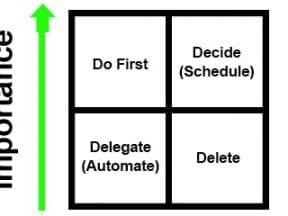
Content marketing works over the long term. It requires commitment and consistency. Failure to define success and maintain quality are among the reasons why content marketing fails.
Content marketing is a powerful tool for engaging potential customers and capturing leads. But businesses owners and managers sometimes feel like their content efforts are failing.
Content marketing works on the concept of reciprocity — the exchange of things for the mutual benefit of both parties. An ecommerce business could offer helpful content in the form of an article, a video, or, perhaps, an app. A consumer engages with that content and later makes a purchase. The business and the consumer benefit. In fact, the customer gets two benefits: the content and the purchased product.
Done well, content marketing can be an important and effective promotional channel. If content marketing is not performing for your company, one of the following reasons could be the culprit.
No Definition of Success
I’m aware of a business owner who thought his content marketing was failing. In the past year, he had invested $60,000 in content. During that time, the site added 1,000 backlinks, increased organic traffic by 58 percent, and generated 1,200 leads each month. Overall, the content contributed to 33 percent of sales or about $4 million in revenue.
The problem was not that the content wasn’t working. The problem was that the business did not have a clear definition of success.
Like all marketing, content efforts should have specific and measurable goals. Your company needs to know these goals before it writes a single whitepaper, ebook, or article.
Put another way, you need a content marketing strategy — goals, milestones, and measurement.
Bad Content
Content marketing is competitive. It has become the mainstay of business-to-business sellers, including seemingly every software-as-a-service business. You are going head-to-head against professional publishers, not to mention other content-generating merchants.
For example, if your ecommerce store sells high fashion, your articles might be competing with online merchants such as Mr. Porter, which does an excellent job, or prominent magazines such as Elle.
The content you create should be one of four things: useful, informative, entertaining, or amazing. And amazing is hard. Most businesses should focus on the other three.
If you find that your content is not measuring up, you have a few choices.
- Invest in professional content creators. Hire freelance writers, photographers, and videographers.
- Become a better content creator. If you write or record most of your company’s content, become better. Take a course, practice, and work on the necessary skills.
- Create something different. Apps and tools can also be a form of content marketing. If you are having trouble garnering attention to your fashion articles, could you develop a fashion app?
Don’t be afraid to compare your company’s content to your competitors’. And don’t be discouraged. Content can be improved, rewritten, and redone. Knowing that you need better content can be the first step to content marketing effectiveness.
No Commitment
Content marketing is a long-term activity. If your company wants to generate more revenue this week, your marketing team should probably use email, pay-per-click ads, or other short-term tactics to drive immediate sales.
In contrast, content marketing is a long game.
It typically requires an editorial calendar — a schedule of posts, podcasts, and similar. All can help generate organic search traffic, email subscriptions, and demand. But these are incremental. They add to success piece-by-piece. The key, therefore, is consistency over the long term.
No Promotion
Content marketing can have three phases and three outcomes.
Content marketing is the act of (i) creating or curating, (ii) publishing, and (iii) distributing. These phases should produce three outcomes: engage an audience, attract new customers, and retain those customers.
Notice that two of the phases, publishing and distributing, are really about promoting content.
For example, imagine you have a podcast. Your podcast is published on SoundCloud, iTunes, Pandora, and four other podcast networks. These networks make the podcast discoverable. They make it possible for an interested consumer to find it.
Your company would also distribute that content. You might embed the podcast in a blog post along with a complete transcription. You could feature it in a weekly email newsletter. You could quote it in a Facebook post. You might reference it in an answer on Quora. Or you could include it in a Reddit thread.
In each case, you are not simply creating content and hoping it will be discovered. Rather you are putting it in places to get noticed or directly sharing it with your potential audience.




